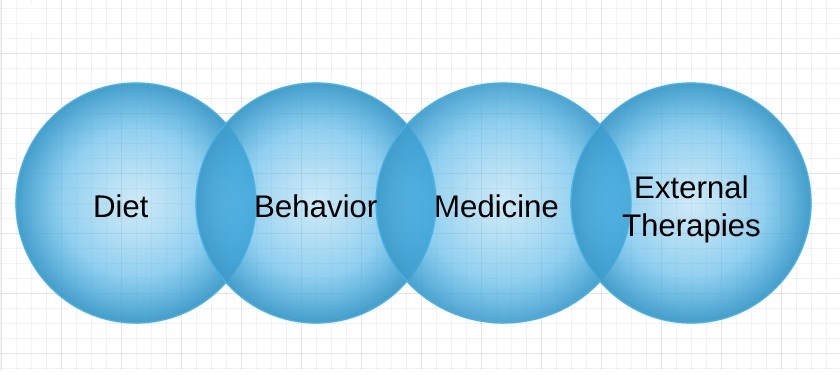Stop Cleaning Your Plate: 5 Steps to More Mindful Eating
By Marcella Friel
I just came home from lunch with a friend, where I ordered Caesar salad with chicken. What arrived at the table was a mountain of romaine lettuce large enough to rival the 14,000-foot peaks in my Colorado backyard.
This was not one, but at least six full portions of salad, intended for one person.
I shrugged, sighed, ate a few handfuls, and pushed the rest away. And no, I didn’t take a doggie bag of soggy lettuce home to sit in my fridge before I threw it out.
Leaving the restaurant, I sadly recalled Chögyam Trungpa’s words in Shambhala: The Sacred Path of the Warrior:
“When people go to restaurants, often they are served giant platefuls of food, more than they can eat, to satisfy the giant desire of their minds. Their minds are stuffed just by the visual appearance of their giant steaks, their full plates.”
In our modern industrial food culture, we face an unprecedented dilemma: We don’t want to waste our food; yet we’re served such huge portions we can’t possibly eat it all.
How do we resolve this?
“Bottomless Bowls” and Compulsive Overeating
In 2005, researchers at Cornell University’s Food Lab had 54 subjects eat soup. Half were served soup in normal bowls with normal portion sizes. The other half were served from a bowl that was imperceptibly, incrementally filled through a tube beneath the table.
The subjects who unknowingly ate from the self-refilling bowls consumed an average of 73 percent more soup, without perceiving themselves as eating more or being more full than their normal-portion counterparts.
When we eat from seemingly bottomless bowls of food, several things happen:
1. We eat from our eyes, not from our bellies. We let the amount of food on the plate tell us how much we should eat. Our body’s natural satiety cues—the messages between brain and belly that say enough—go haywire. We lose our sense of where full ends and overstuffed begins.
2. We feel guilty. We’ve all heard the admonition, “Eat your food! There are children starving in Africa!” If we have any social conscience, we know well the injustices of food access and distribution around the planet. And that guilt subconsciously spawns the struggle to eat the food when we know we really can’t.
3. Eating becomes a chore rather than a pleasure. If, as food journalist Michael Pollan says, “The banquet is in the first bite,” there’s no point in savoring our excessive fare if none of it is precious to us. We lose our connection to appreciation and nourishment and instead plod through the grim task of getting calories into our body. And that, according to Trungpa Rinpoche, is where civilized society ends and barbarism begins.
4. We get fat. Marion Nestle, Food Studies Professor at New York University, positively correlates obesity rates with supersized food:
“The larger portion business started at exactly the same time that obesity rates started to go up…. Muffins used to be one or two ounces; now they’re six or seven or eight…. When I was a kid, bagels were the size of what are now called mini-bagels. And you never used to go into a restaurant and be presented with a bowl of pasta that would feed six people. You’re presented with this now, and you’ve got to do something with it.”
You’ve got to do something with it. What do you do?
Reclaiming Sanity and Satiety
In our all-you-can-eat culture, it’s time to jettison the “clean-your-plate” rule and reclaim our body’s natural ability for genuine satisfaction.
Where do we begin? Here are some suggestions:
1. Pause before you eat. Stop. Close your eyes. Take three deep, conscious breaths. If it’s comfortable to do so, place your hands on your heart. Affirm your intention to eat consciously. Ask your body to help you recognize when you become full.
2. Put down your utensil between bites. It takes about 20 minutes for the brain and belly to determine satiety. Putting down your spoon or fork causes you to slow down and chew, which activates the digestion process and causes your body to pay attention.
3. Practice hara hachi bu. The Japanese rule of mindful eating is, “Eight parts out of 10 full.” While putting down your utensil, check in with your body’s fullness. Don’t worry if you can’t tell right away; keep practicing and reaffirming your desire to know, and it will come.
4. Complain (kindly). If I had today’s lunch to do again, I would have mentioned to my food server that the salad was way too big. Most retailers know that if five customers ask for something, it’s time to make a change. Be one of the five. Speak up.
5. Stop cleaning your plate. As Frances Moore Lappé said in her groundbreaking book, Diet for a Small Planet, “Hunger is not caused by lack of food but by lack of democracy.” Eating more food than our bodies can handle is not the antidote to global starvation. Let the food go if you truly cannot eat it.
Recovering the natural dignity of our bodies and reclaiming the inherent sanity of our eating habits opens the portal to a transformed self and a healed world. As Trungpa Rinpoche wrote,
“When you make an effort to eat mindfully, you find that life is worth much more than you had expected…. You find that life is more sacred…. People found the same thing two thousand five hundred years ago. They found it and they taught it to us, and now we are discovering it ourselves.”
Shambhala Mountain Center hosts Mindful Eating: Learn EFT to Liberate Yourself from Unwise Food Choices with Marcella Friel, January 15-17, 2016 — click here to learn more
Also check out this great video!
About the Author










